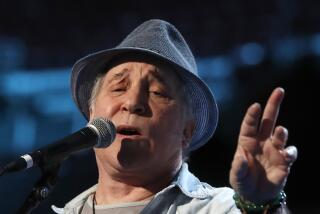Science / Medicine : ‘Electronic Inner Ear’ Gives Shower of Noise
- Share via
Slowly--the words must always be spoken slowly, with careful enunciation--the question came at Urban Crispin, a big, jocular, retired toy salesman.
“What’s the best sound you’ve heard since the operation?” asked Sherri Lewellen, Crispin’s hearing rehabilitation specialist.
“Your voice,” Crispin shot back quickly, grinning.
“ My voice?” Lewellen said, puzzled, not sure Crispin understood the question.
“Who hooked me up?” Crispin said. “Who was the first person I heard?”
Lewellen smiled. So did Dennis Maceri, the doctor who last fall surgically implanted a small receiver under the skin behind Crispin’s left ear at Hollywood Presbyterian Hospital.
During the previous 10 years, Crispin had moved sluggishly through life, no longer able to hear, unable to benefit from even the strongest hearing aid and unable to master lip-reading or sign language. If you wanted to talk to him, you wrote the words on a pad of paper. When he talked back to you, it sounded like a megaphone because he couldn’t hear enough to modulate himself.
But during the last couple of months, to his continued amazement, Crispin, 76, has found himself on the cutting edge of a long-awaited but still little-used procedure that uses computerized sound-processing technology to restore hearing to people who had given up hope.
He is one of 700 people in the world, and 500 in the United States, outfitted with a 22-channel “electronic inner ear.”
What he hears, thanks to a network of electrodes that stimulate tiny nerve fibers in his ear’s hearing nerve, is a shower of everyday sounds and noises that might confuse or disorient someone accustomed to normal hearing. Some have compared it to the crackling, synthesized, incomplete voice of a computer with poor enunciation, or a poorly tuned radio.
However, through painstaking practice, Crispin has learned to translate the jumble of sounds into the language that he remembers.
Wearing a miniature speech-processing computer that takes up about as much room in his shirt pocket as a Sony Walkman, Crispin can carry on a conversation if the environment is quiet and his companion is cooperative. He can order in restaurants. In a jam, if it’s too noisy, he now has enough auditory cues to successfully lip-read. He talks on the telephone from his home in San Diego to his daughter in Costa Mesa.
It’s far from perfect. But, Crispin says, it beats the heck out of being almost deaf.
“No more of this stupid pen and paper,” Crispin says as if he were describing lost warts.
The idea that implants could restore hearing to people who could no longer be helped by conventional hearing aids goes back at least four decades. But it was not until 1984 that the Food and Drug Administration approved one for marketing.
That device, a single-channel implant developed by the House Ear Institute in Los Angeles and manufactured by Minnesota Mining & Manufacturing Co. of St. Paul, Minn., crudely duplicated the function of the inner ear, known as the cochlea: It turned sound into electrical current and sent it to the brain for interpretation.
In the healthy cochlea, the work of converting current to sound is done by tiny nerve endings known as hair cells, which activate the hearing nerve. In what is commonly called “profound sensory-neural deafness,” affecting as many as 2 million people, the hair cells are damaged or destroyed, so the message cannot get through. In most of these cases, however, the hearing nerve itself is actually functional. The trick is finding an artificial way to stimulate the nerve.
About 1,000 people now wear the House device, which costs about $6,000.
What Crispin wears is a newer, snazzier, second-generation device.
His $13,000 multichannel implant, marketed by Denver-based Cochlear Corp., receives and transmits sound on 22 separate frequencies, providing superior separation and clarification.
While several other companies have developed ear implants that are used by doctors on an experimental basis, the House and Cochlear models are the only ones to so far win FDA approval. The Cochlear implant, developed in Australia during the 1970s, was approved for marketing two years ago.
The FDA has approved the House and Cochlear implants only for persons over 18 who are “post-linguistically deafened”--were able to speak before they lost their hearing. Implants in children have been permitted on an experimental basis.
The critical variable of adjustment has made the agency cautious about letting the implants be used in young adults or children, an FDA spokesman said.
For implants to succeed, hearing specialists say, the recipient must be motivated and patient enough to teach himself to interpret the distorted sounds he will hear. There are concerns that a post-linguistically deafened child might not have experienced enough years of hearing to put the new stream of sounds into proper context.
These same concerns make the implant an imperfect process for adults.
Ideally, doctors look for patients who have been without hearing long enough so that they won’t compare normal hearing with the new sounds, but haven’t been without hearing so long that their hearing nerve has deteriorated. The patient should have a supportive family and a clear desire to rejoin the hearing community.
Consumer skepticism and questions about the difficulty of adjustment and the cost of the surgery have contributed to the limited use of ear implants, according to doctors and others familiar with the technique.
“We’re just not convinced yet that it still isn’t experimental surgery,” said Dr. Glen Taylor, a consultant in the benefits branch of Medi-Cal, California’s health insurance program for the indigent. “The evidence for good is still outweighed by the bad.”
Medi-Cal does not cover ear implants. However, many private insurance companies and Medicare, the federal government’s health insurance program for the elderly, do cover all or part of the expense, which can range as high as $28,000 for the Cochlear implant when surgery and follow-up visits are included.
Dr. Jack Pulec, the owner of a Los Angeles ear clinic who has performed several implants and is familiar with other multichannel implants awaiting FDA approval, said he expects the number of recipients to expand tremendously during the next five years.
“Most of the implants that are in use now are the single-channel variety that, while useful, didn’t give people speech as such--they gave them sound awareness and better lip-reading,” Pulec said. “The multichannel units truly offer to the average patient a reasonable improvement. They get somewhere between 30% and 70% understanding of words. . . . They’re back to the hearing world.”
‘Made His Living Communicating’
It was a world that Urban Crispin was desperate to rejoin.
Crispin lost his hearing in ways that mystified both him and his doctors. About 15 years ago he experienced a persistent noise in one ear. “We lived next to a canyon, I thought it might have been the environment, but we left that home and the noise followed me,” he said. “The hearing in that ear disappeared. They said there was nothing they could do about it. . . .
“Then five years later I was playing tennis, which is a lifelong habit, and I noticed the ball didn’t ring the same way when it came off the racket. I played the rest of the game defensively, went home, turned on the TV and the other ear had gone bye-bye, too.
“The doctors told me I had lost 90% of my hearing in both ears. That means you’re in no-no land.”
One doctor told him to learn lip-reading. He couldn’t get the hang of it. He got 1 out of 100 on one test.
He tried another hearing aid. “I got the biggest one they had, and I could hear a siren coming within five feet of me, and that was about it. Communication--dead. Music--dead.”
Business--dead, too. It was the month of October when his second ear failed. The Christmas toy season was beginning. It would be nightmarish.
“I had to get somebody else to do my phoning. It was a little bit of a crazy deal. The next year, after the cloud settled, I realized there wasn’t any hope.” He quit and tried to go into business fixing up and reselling homes, where communication wasn’t so important.
Crispin kept seeing a doctor for his hearing but said his appointments turned into mostly social visits. It was not until last fall that his doctor suggested that he consider an implant.
Crispin, far older than the average recipient, realized that the solution was imperfect but felt that he had no other option.
“I hate cowards,” he said. “You never get anywhere standing still.”
Several weeks after the operation he began the 30 to 60 hours of adjustment visits that are normally required to literally tune and retune the pocket-size speech processor to pick up the most helpful mixture of sounds.
“When you first get hooked up you don’t like it, because it’s so different,” Crispin said. “. . . I remember the normal sounds. But based on the similarities between that and what I hear now, and a thousand other things, you adapt. Normal sound is more harmonious than what I hear. This is like a high-frequency buzzer.”
One of the ironies of implant technology is that noise--airplanes, rain, water fountains--is picked up more easily than spoken words. The user must sort out the distractions. Even in a quiet room, Crispin often struggles. So far he appears to fit into the middle range of success, according to audiologist Lewellen.
One thing he has noticed is that “women, as a rule, with their high voices tend to come in better with me than men.”
Crispin, who is single, paused and glanced at the ceiling of Maceri’s office and smiled toward the heavens.
“Thank you,” he said.






